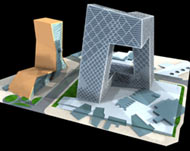China’s cities dream of cultural grandeur
To be a modern Chinese city, youshould exhibit signs of culture and cosmopolitanism as well.

Investing nearly $500 million in a series of gargantuan cultural projects, the southwestern Chinese city of Chongqing is helping lead the way among the country’s second-tier cities in saying that that it is no longer mere GDP growth rates that defines a metropolis’s success.
While Beijing and Shanghai boast bohemian art districts, architecturally impressive performance and exhibition facilities, and stopovers from world-renowned productions, the likes of Chongqing, with its reputation for heavy industry and permanent smog, remains that of a cultural philistine.
That scene, however, is slowly being re-scripted.
According to an official at the city’s cultural bureau, ten large-scale cultural projects are set to soon rise out of the Yangtze mud, including a $97 million international standard theatre, a $36 million library and even a $12 million Chinese modern art gallery – a cultural medium the authorities still have trouble accepting,
Changing attitude
Such investment is indicative of a changing attitude among city governments who, in addition to investment in industry and infrastructure, are now also considering the intellectually finer things in life.
“The Chongqing government believes these projects to be a necessary stage of development. By promoting culture we will make the lives of our citizens more varied and we will represent our civilisation by displaying Chinese culture to the outside world,” the official told Aljazeera.net, justifying the considerable expense in a comparatively impoverished part of China.
 |
|
City officials are focusing on the |
With such lofty ideals, Chongqing has ambitions to become the cultural centre of western China – ambitions of cultural greatness shared by other cities. A sampler:
• A five-year, $1.3billion investment by the Guangzhou city government in some 26 projects including libraries, concert halls, art galleries and museums series.
• An investment by the eastern city of Hangzhou into theatres and museums in response to complaints that residents had to go to nearby Shanghai to experience anything cultural.
• Last week, the northeastern city of Changchun – a self-styled Detroit of China due to its car industry – got to enjoy a spectacle of some of the continents leading artists as the Asian Arts Festival came to town.
• In October, as part of a series of Sino-Franco exchanges, an exhibition of leading contemporary French art will be held in Jinan, the capital of coastal Shandong province.
Competition
Symbolic of how each city is now positioning itself in terms of cultural grandeur, Chongqing’s only major metropolitan neighbour, the city of Chengdu, challenges the notion that Chongqing should be western China’s cultural capital.
“Chengdu people like culture more than Chongqing,” local artist Yang Mian says. “Here people prefer newspapers and books to television, they respect art.”
 |
|
Yang Mian is helping run the first |
Helping to run Chengdu’s first modern art gallery, Yang’s parochial snobbery is emblematic of the proverbial jousting between cities as to who can boast the better living environment.
“Chinese cities these days are beginning to pay attention to the cultural needs of their citizens.” Wei Dong of the Chongqing Federation of Literary and Art Circles told Aljazeera.net.
Although an opaque term and one laden with political symbolism, the numbers of middle-class members are, according to official figures, continuing to rise.
Now apparently standing at some 15-19% of the population, the investment in cultural infrastructure is in part, a reflection on the growth of this powerful consumer group.
“I think these investments are mainly a response to demands from local inhabitants,” Benjamin Ou, an adviser with an international consultancy said. “With rising living standards come rising expectations.”
In addition though, in the heated competition among cities and regions to attract foreign investment, city governments are conscious that having a competent infrastructure, including cultural facilities, can play a positive role in wooing investors.
Wide scope
About to host its annual international photographic exhibition, the ancient walled city of Pingyao in central Shanxi province is a case in point.
Last year exhibiting 7000 works from fourteen countries, the event attracts sponsorship from the likes of mobile phone makers Alcatel and magazine publishers Hachette Filipacchi Medias.
 |
|
New buildings are coming up in |
At their press conference in Beijing, it was not just the exhibition that was promoted.
Included among the literature were brochures in both Chinese and English telling companies why they should be investing in Pingyao’s industrial facilities.
“Although economic considerations will be the first choice for any company planning an investment, the attractiveness of a city’s livability and development will also be a factor when making decisions about where to locate,” said Ou.
The only problem that remains is what to do with the spaces once they are opened. At the Chongqing cultural bureau, the official admitted that the purchasing of arts and antiquities to fill the empty halls had not yet begun, nor had a potential line-up even been confirmed.
“It will though be both international and local in scope,” he added reassuringly.